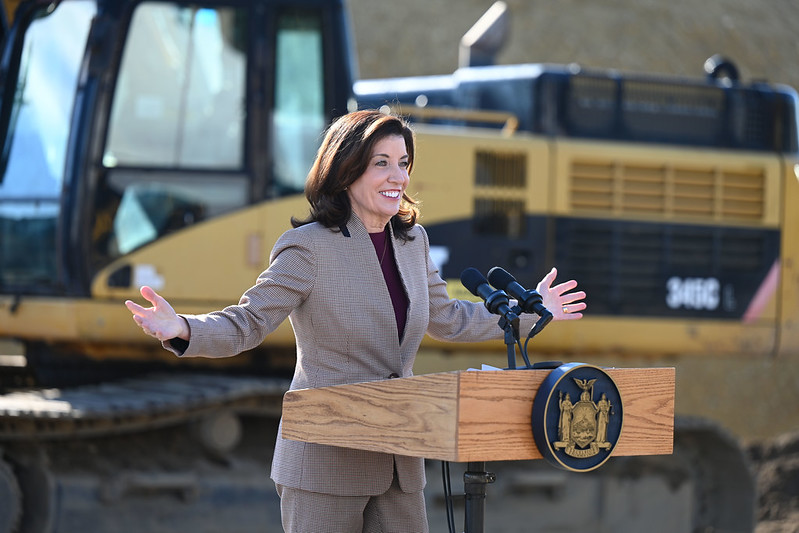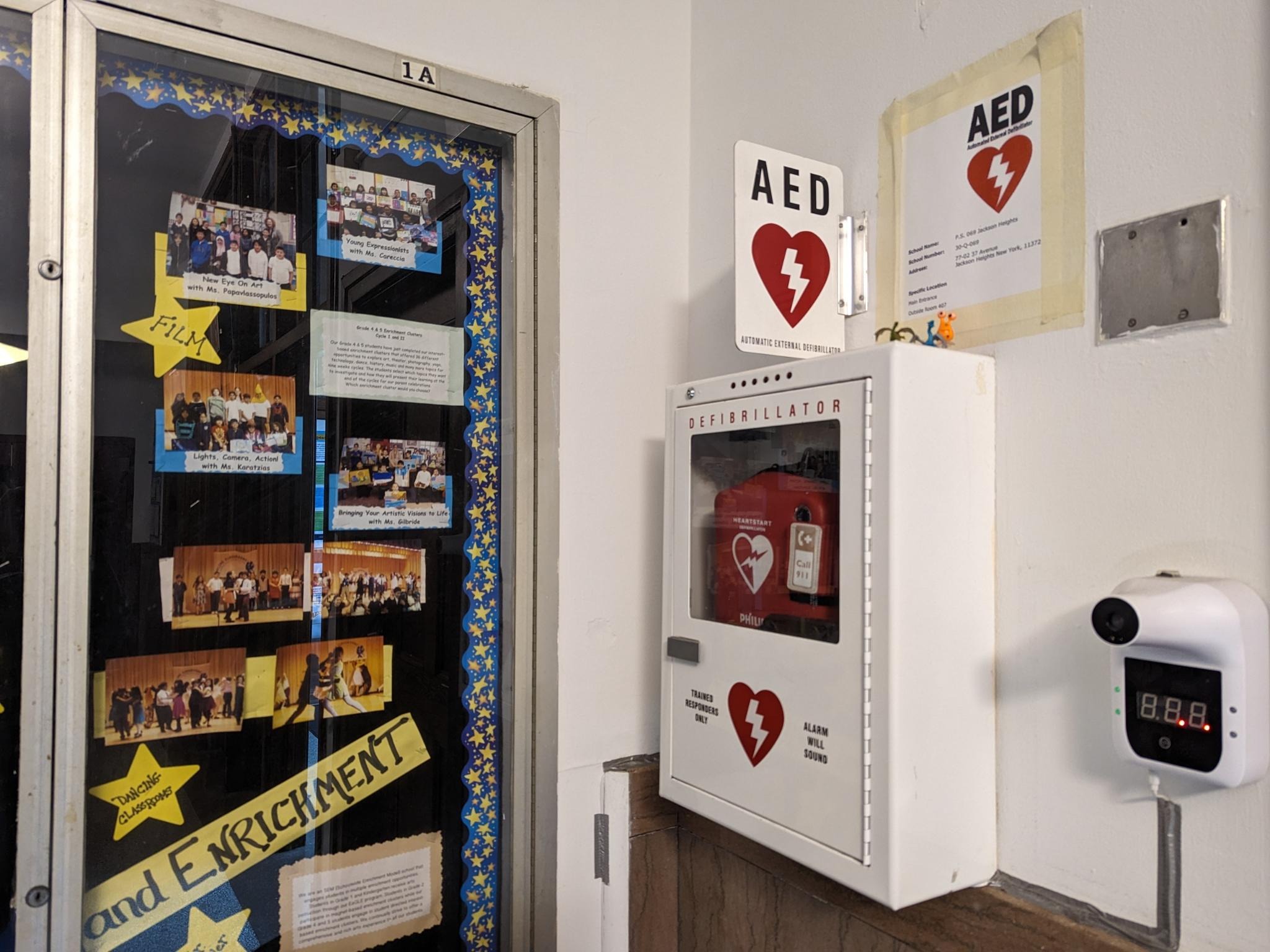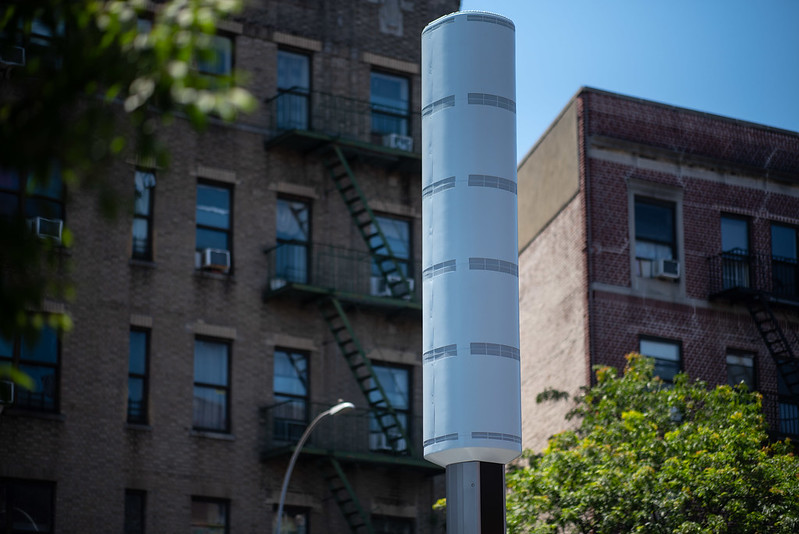How Governor Hochul Can Make Progress on Housing Through Executive Action

Governor Hochul (photo: Kevin P. Coughlin/Office of the Governor)
The most pressing issue facing New York is a lack of housing. A Regional Plan Association analysis shows that the state needs to build 817,000 more homes over the next decade to address shortages and meet expected population and job growth – the root cause of many symptoms currently ailing New York City.
For example, according to the city’s most recent Housing and Vacancy Survey, the median renter household makes $50,000 a year – but to afford a typically available apartment, renting for $2,750, that household needs to make $110,000. Is it any wonder that we have a nation-leading rate of chronic homelessness, with a nightly count surpassing 80,000 residents?
It was against this backdrop that Governor Hochul advanced ambitious housing goals this year, and it is against this backdrop that she, to her credit, will do so again next year despite the powerful and prevailing anti-housing forces. To be successful next session and to address the crisis of our age, however, there are several executive actions that the Governor can take on her own to spur housing development, regardless of local zoning.
With these actions, the Governor will show New Yorkers that she won’t back down from a challenge, and that “not in my backyard” isn’t an acceptable response.
First, the state should create affordable housing on the land it owns, as Governor Hochul has already signaled that she will do.
This is an opportunity for New York to fully maximize the potential of its own sites and lead by example. The Metropolitan Transit Authority owns some vacant parking lots on Long Island – it should follow in the footsteps of its California counterpart and work with other state agencies to redevelop them with housing. The state also has a number of abandoned psychiatric hospitals that could be redeveloped into housing – the 365 acres of the abandoned Kings Park Psychiatric Center, for example, are walking distance from a community college and an industrial park, and they’re only a mile-and-a-half from a Long Island Rail Road stop.
Second, Empire State Development (ESD), through the powers of the Urban Development Corporation, can build residential developments regardless of local zoning. This means that even without state land, ESD could use a “general project plan” to work with local landowners and private developers to build affordable and mixed-income housing. In exclusionary municipalities highly unlikely to ever allow affordable (or even multifamily) housing, this would be warranted.
Third and finally, the state should investigate localities that may be violating fair housing laws.
For instance, as a condition of approving a zoning change, Mount Pleasant recently forced Toll Brothers to age restrict a new development to residents over the age of 55 and local officials specifically cited school impact as a primary reason. While age-restricting a development is legal, it can be discrimination if you’re doing it specifically to exclude families with children.
Taken together, these measures are an important tool not just to create more housing, but also to affirmatively further fair housing. Restrictive zoning has not only driven up housing costs — it’s also resulted in sky-high levels of segregation.
The Regional Plan Association has demonstrated a clear correlation between exclusionary zoning and racial makeup of communities in the New York City region — with single-family zoned communities being almost entirely white, while multi-family-home communities are mostly inhabited by people of color. UC Berkeley found that New York has the most segregated school system in the country for Black students and the second most segregated school system for Latinos. And the Brookings Institute has shown that the New York City region has the second-highest level of Black-white residential segregation in the country, after only Milwaukee.
Over the last hundred years, zoning has become ever more restrictive across the state, and we have no reason to believe that municipalities will suddenly decide to do the right thing without state action. Instead, we must look to the state to solve the twin crises of housing supply and housing segregation.
State government respects leaders who are willing to play hardball. By taking strong, executive action on housing, the Governor can make it clear to all New Yorkers that she is going to tackle the biggest issues facing the state — and she will likely have greater leverage during next year’s budget process.
***
James Lloyd is the director of policy for the New York State Association for Affordable Housing. On Twitter @NYSAFAH.
***
Have an op-ed idea or submission for Gotham Gazette? Email This email address is being protected from spambots. You need JavaScript enabled to view it.
An AED on the Sidelines Saved Damar Hamlin; They Should Be Available to Everyone

An AED in P.S. 69, Jackson Heights, Queens
In January, America watched in horror as Buffalo Bills safety Damar Hamlin collapsed onto the field, moments after making a routine tackle during a game against the Cincinnati Bengals. Twenty-four years old and in peak physical health, Hamlin had suffered a sudden cardiac arrest in front of thousands in the stands and millions tuned into Monday Night Football.
Thanks to good planning and training, the Bills' medical team on the sidelines had an automatic external defibrillator on hand, commonly known as an AED. Within seconds, these first responders used the AED to shock Hamlin's heart back into a normal rhythm as he awaited transport to a local hospital. The device not only saved his life, it also restored blood flow quickly enough to prevent permanent damage to his brain. Later that same month, Damlin was able to cheer on his team from the sidelines in its rematch against the Bengals. Today, he is back on the field, and his resilience and infectious optimism are an inspiration for us all.
As Damar’s story makes clear, AEDs save lives. Unfortunately, however, they aren't as readily accessible for everyone as they were for him. They should be, and we're both sponsoring legislation – on the federal and municipal levels – to make sure they are.
Each year, more than 356,000 people in the United States suffer cardiac arrest outside of the hospital, including more than 7,000 children. What the nation witnessed during Monday Night Football in January happens every day in our schools, playgrounds, and parks. A basketball player collapses after taking a rough shoulder check. A teacher trips and stumbles in the hallway clutching her chest. A high schooler falls to the grass after making a tackle during football practice.
In these terrifying situations, the evidence of AEDs' effectiveness is as impressive as it is unequivocal. According to the American Heart Association, the chance of survival for someone experiencing cardiac arrest outside of the hospital is less than 10%. That jumps to an average 40% survival rate when professional first responders like firefighters or emergency medical technicians use an AED. Incredibly, the chance of survival is highest when non-professional first responders use an AED: greater than 50%.
This is because non-professional bystanders – often coaches, teachers, or friends – can respond much more quickly than even the fastest ambulances in the critical moments right after the start of an irregular heart rhythm. It's also because modern AEDs are semi- or fully-automated. They provide clear verbal, and often visual, instructions that an average person can follow with only basic training.
The life-saving benefits of AEDs are obvious, which is why they have been placed in more and more public locations over the last several decades. President Clinton signed the Cardiac Arrest Survival Act in 2000, placing the devices in federal buildings and providing millions in grants for local deployment. Two years later, President Bush signed the Community Access to Emergency Devices Act, allocating millions more for states and localities to purchase AEDs and train first responders in their use. Besides the federal government, 20 states – including our own state of New York – require placement of AEDs in all public schools. But progress has stalled in recent years.
Hamlin's cardiac arrest makes a clear call to action: we must enact legislation to expand access to even more communities. At the federal level, Leader Schumer’s bipartisan Access to AEDs Act will provide grants to place devices in elementary and secondary schools nationwide, and will fund the development of school-based cardiac emergency response plans. And in New York City, Council Member Krishnan’s HEART (Harihareswara Expand Access to Rapid Treatment) Act will require the Department of Health to publish online the precise locations and quantities of all publicly-accessible AEDs within the five boroughs, whether in schools, firehouses, or government office buildings. If loaded into common mapping apps on our smartphones, this data can make AEDs as quick and easy to find as a cup of coffee.
Together, these laws can ensure that these miraculous devices are immediately accessible where most cardiac arrests occur – not in pro sports stadiums, but near our rec centers, public ballfields, and school yards. With easy-to-locate, ubiquitous AEDs, we can save countless people from cardiac death, from elite athletes like Damar Hamlin to ordinary New Yorkers like us.
***
Charles Schumer is the U.S. Senate Majority Leader. Shekar Krishnan is a City Council Member representing parts of Queens. On Twitter @SenSchumer & @voteshekar.
***
Have an op-ed idea or submission for Gotham Gazette? Email This email address is being protected from spambots. You need JavaScript enabled to view it.
5G Towers: To Increase Digital Connectivity, Start by Connecting with the Community

A 5G tower (photo: Michael Appleton/Mayoral Photography Office)
If you have walked around New York lately, you may have noticed a new addition to the streetscape: 32-feet-tall 5G towers looming over city sidewalks. As expected, these towers have inspired a range of colorful descriptions from New Yorkers for their uninspired design and massive size. From Washington Heights to Carnegie Hill, everyone seems to be raising the same questions and concerns about the design and placement of the 5G towers.
The city’s goal of expanding 5G communications is both laudable and necessary; in the new hybrid world of remote meetings and online work, access to high-speed internet is essential. The 5G towers, which are operated by a consortium named CityBridge, are supposed to be part of the solution by bringing complete connectivity to all parts of the city. To achieve this important goal, nearly 2,000 5G towers are to be installed citywide.
As representatives for the communities receiving the first rollout, we can attest that the process has not been a success -- with a failure to provide essential data about siting locations, insufficient community engagement, and a negligence of the appropriate federal siting approval processes.
For instance, a very common and reasonable request is for the city to explain why a certain location or block was chosen. CityBridge claims that network carriers, like AT&T, Verizon, and T-mobile, have shared coverage gaps with them and that determines where the towers go. However, to date, they have failed to share this data with elected officials or the public.
This lack of information leads many New Yorkers to rightfully question if this new arrangement is an effort to drive more revenue rather than the altruistic goal of expanding service to the most necessary and desirable locations.
Furthermore, the design of these towers leaves much to be desired, especially when placed near historic districts and landmarked buildings. Greater efforts should be made to ensure the design matches the surrounding area. We can also approach the towers as a creative opportunity by allowing artists to add a splash of color, much like the MTA partners with artists and poets to enhance the subway. Doing so could transform towers into local landmarks as opposed to dull, unappealing poles on the sidewalk.
Considering the issues raised, we believe that the towers – where truly necessary -- should be installed in a more deliberate, transparent manner that provides an opportunity for people near potential sites to have a say in the siting process while accessing the necessary data to back up the choice of location.
This week, the New York City Council’s Committee on Technology will hold an oversight hearing on the rollout of the 5G towers to explore these questions and more. The hearing will be an opportunity to hear from technology experts, community groups, and CityBridge. It will hopefully shed light on what is truly guiding the placement of these towers and where they are needed.
The hearing will also allow us to better understand how 102 towers were installed without going through the appropriate FCC review processes. In an April 20 letter, the FCC determined that CityBridge had not gone through the required historic preservation and environmental reviews as mandated under the National Historic Preservation Act and National Environmental Policy Act, respectively. The letter also ordered that the 102 towers already installed be subject to a “post construction review.”
The rollout of citywide 5G represents an opportunity to bridge the digital divide and ensure every New Yorker has online access. However, crucial questions must be answered to determine if the current approach is the best way to go about it. An opaque, top-down process understandably invites suspicion and controversy, and it is time to bring the public to the table. At the end of the day, these towers are installed in public space and the public has a right to be a part of the process.
***
City Council Members Keith Powers and Carmen De La Rosa each represent parts of Manhattan. On Twitter @KeithPowersNYC and @CnDelarosa.
***
Have an op-ed idea or submission for Gotham Gazette? Email This email address is being protected from spambots. You need JavaScript enabled to view it.




